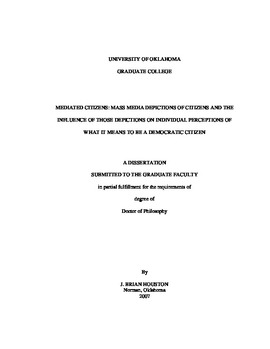| dc.contributor.advisor | Pfau, Michael, | en_US |
| dc.contributor.author | Houston, J. Brian. | en_US |
| dc.date.accessioned | 2013-08-16T12:20:53Z | |
| dc.date.available | 2013-08-16T12:20:53Z | |
| dc.date.issued | 2007 | en_US |
| dc.identifier.uri | https://hdl.handle.net/11244/1251 | |
| dc.description.abstract | The survey portion of this study found that overall media use had a weak impact on perceptions of what it means to be a democratic citizen. However, while media use did not strongly influence individual perceptions of what it means to be a democratic citizen, the media did exhibit a potential to impact individual perceptions of citizenship as when associations between media use and citizen attitudes were found, they were generally supported by media content patterns. The overall weak impact of media use on perceptions of citizens is likely due to citizens not appearing frequently enough in media content, as well as the inherent complexity of the citizen concept. | en_US |
| dc.description.abstract | In addition to describing the ways in which media use impact perceptions of democratic citizenship, this research also outlines the extent to which citizen depictions are the same for the media forms included in this project, the ways that citizen depictions differ between the individual media modalities, and the ways in which citizens depictions differ between traditional and new media forms. | en_US |
| dc.description.abstract | This study examined how the mass media depict democratic citizenship, how individuals think about what it means to be a democratic citizen, and how the two are related. To address these issues a content analysis of television news, cable talk news, late night comedy news, and newspaper content was conducted to determine how the media depict citizens. In addition to the content analysis, individual perceptions of democratic citizenship were assessed through a national telephone survey. To compare the ways in which media depictions and individual perceptions of citizens were related, this study proposed a citizen framework of three key citizen dimensions: knowledge, activities, and decision-making standards. Media content and individual perceptions of citizens were compared along these three dimensions. | en_US |
| dc.description.abstract | The content analysis portion of this project found differences in the ways that traditional media modalities (television news and newspapers) and new media (cable talk news and late night comedy news) depicted citizens. Traditional media included more depictions of citizens than did new media. Traditional media content also associated citizens with social capital activities more often than did new media content. New media depicted citizens with greater amounts of agency than did traditional media, but traditional media depicted citizens in a more positive tone and as possessing more knowledge than did new media. The content analysis also documented ways in which citizen depictions were similar for all media modalities. The Iraq war was a popular citizen issue for all media modalities, and all media depicted citizens most frequently as individuals compared to any other group association. | en_US |
| dc.format.extent | xv, 207 leaves : | en_US |
| dc.subject | Mass media and public opinion. | en_US |
| dc.subject | Political Science, General. | en_US |
| dc.subject | Mass media and propaganda. | en_US |
| dc.subject | Mass Communications. | en_US |
| dc.title | Mediated citizens: Mass media depictions of citizens and the influence of those depictions on individual perceptions of what it means to be a democratic citizen. | en_US |
| dc.type | Thesis | en_US |
| dc.thesis.degree | Ph.D. | en_US |
| dc.thesis.degreeDiscipline | Department of Communication | en_US |
| dc.note | Adviser: Michael Pfau. | en_US |
| dc.note | Source: Dissertation Abstracts International, Volume: 68-07, Section: A, page: 2709. | en_US |
| ou.identifier | (UMI)AAI3274522 | en_US |
| ou.group | College of Arts and Sciences::Department of Communication | |
